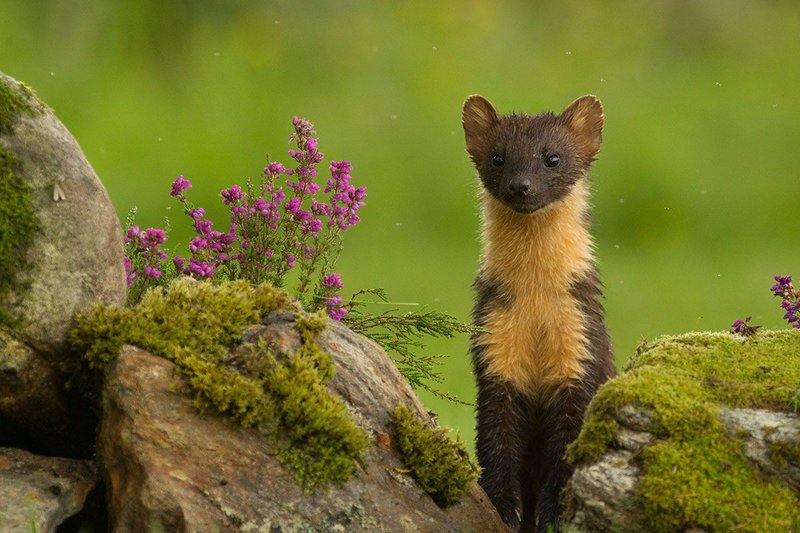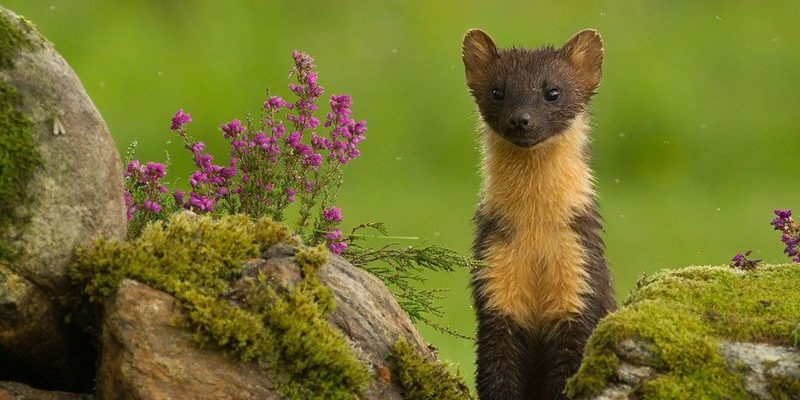
What Are Martens?
Martens are small to medium-sized mammals belonging to the family Mustelidae, which also includes weasels, otters, and ferrets. Picture a small, agile creature with a bushy tail, a slender body, and a coat that can range from golden-yellow to rich brown. These playful animals are found in various habitats across the northern hemisphere, showcasing their adaptability and charm. They are known for their curiosity and intelligence, often engaging in playful antics that can entertain anyone lucky enough to spot them.
You might be wondering what sets martens apart from other mustelids. For starters, they have a unique combination of physical features—like their long, sharp snouts and playful demeanor. They’re not just cute; martens play a significant role in their ecosystems by controlling rodent populations and serving as prey for larger predators. Let’s take a closer look at what makes these animals so fascinating.
Types of Martens
There are several species of martens, but the most commonly recognized are the European marten and the American marten. Both species share similar traits but also exhibit some fascinating differences. The European marten, for example, has a more varied fur color and tends to be a bit larger than its American cousin.
The American marten is typically found in forests of North America, particularly in the northern regions. They thrive in environments with plenty of cover, like dense trees and underbrush. European martens, on the other hand, have adapted to a wider range of habitats, from forests to urban areas.
No matter the species, martens are known for their agile climbing abilities. They can often be seen scaling trees in search of food or a safe place to rest. In fact, their skills in climbing are so impressive that they can easily evade larger predators, making them elusive and intriguing animals.
Physical Characteristics
Martens are designed for life in the trees and forests. Adult martens usually weigh between 1.5 to 2.5 kilograms and measure around 50 to 70 centimeters long, including their long tails. Their slim bodies and short legs allow them to move quickly through their environment, whether it’s racing across the ground or navigating the branches overhead.
One striking feature of martens is their fur. The coats of these animals are thick and luxurious, helping them stay warm in cooler climates. This fur also comes in a variety of colors, often depending on their habitat. For instance, forest martens often have darker, richer colors to blend into their leafy surroundings, while those in more open areas may be lighter.
Their sharp claws and teeth are perfectly adapted to catch prey. Martens are primarily carnivorous, munching on small mammals, birds, and insects. They have an incredible sense of smell, which they use to locate food buried under snow or leaves. This keen hunting skill makes them efficient predators in their ecosystems.
Habitat and Distribution
Martens are quite adaptable and can be found in various habitats. They prefer temperate forests, where they have an abundance of trees for climbing and lots of cover for hunting. You’ll often find them in mixed deciduous and coniferous forests, where they can thrive among the biodiversity.
Their distribution spans across Europe, Asia, and North America. In the United States and Canada, they primarily inhabit northern forests but can also be found in the Rocky Mountains and the Pacific Northwest. The European marten, on the other hand, has a broader range that includes urban areas, showing just how well they can adapt to human environments.
Interestingly, martens often use tree cavities and abandoned nests for shelter. This behavior allows them to escape harsh weather and predators. Additionally, they are known to create their own dens under the roots of trees or in hollow logs, providing them with safe spaces to rest and raise their young.
| Characteristic | Value |
| Weight | 1.5 – 2.5 kg |
| Length | 50 – 70 cm |
| Average Lifespan | 5 – 10 years |
| Diet | Carnivorous (small mammals, birds, insects) |
| Habitat | Temperate forests |
Diet and Feeding Habits
When it comes to feeding, martens are opportunistic hunters. Their diet mainly consists of small mammals, including voles, squirrels, and even rabbits. They’re skilled climbers, so they won’t hesitate to snag a bird from a low branch or scavenge from nests. Their hunting technique often involves stalking quietly and using their sharp senses to pinpoint their next meal.
Martens also enjoy a variety of berries, fruits, and nuts, particularly in the fall when food sources can be scarce. This omnivorous tendency helps them survive in different environments. The ability to adapt their diet based on what’s available is one of the reasons they thrive in such diverse habitats.
Interestingly, martens are known for caching food, which means they store leftovers for later. This behavior helps them prepare for harsh winters when food becomes less accessible. Imagine them hiding a tasty morsel under a pile of leaves—smart little hoarders!
Behavior and Social Structure
Martens are generally solitary animals, except during mating season or when a mother is raising her young. They have well-defined territories, which they mark using scent to communicate with others. This territorial behavior is essential for avoiding confrontations with other martens and ensuring they have enough food resources.
While often seen as solitary, martens can show playful behaviors with one another, especially when they’re young. They engage in wrestling and chasing games, which are important for developing skills needed for survival. These playful interactions allow for social bonding, albeit briefly, before returning to their independent ways.
You might find it fascinating that martens are also quite vocal. They emit a range of sounds, from chirps to growls, especially during mating season or when they feel threatened. These vocalizations serve as essential communication tools in their habitats, alerting others about danger or attracting mates.
Conservation Status and Threats
As charming as martens are, they face several threats in the wild. Habitat loss due to deforestation and urban development is one of the main concerns. As forests shrink, these animals lose their homes and food sources, making survival challenging. Additionally, they’re vulnerable to road accidents and predation by larger animals.
Some areas have implemented conservation efforts to protect martens, including habitat restoration and legal protection against hunting. Community awareness and education about the importance of preserving these creatures can also significantly impact their populations. For instance, promoting wildlife corridors can help martens access necessary habitats and reduce road fatalities.
While the future for martens isn’t without challenges, ongoing conservation efforts are crucial for their survival. It’s heartening to see communities come together to protect these playful animals, ensuring they continue to thrive in our forests.
FAQ
What do martens look like?
Martens have a distinctive appearance with a slender body, long bushy tail, and sharp features. Their fur can range from shades of yellow-brown to rich dark brown, often with lighter patches on their throats. These features not only make them look appealing but also help them blend into their forest environments.
Are martens dangerous to pets?
Generally, martens are not dangerous to pets but can pose a threat to small animals like cats and small dogs. Their hunting instincts are strong, and they might see very small pets as potential prey. It’s best to supervise pets when they are outdoors in areas where martens are known to roam.
How long do martens live?
Martens can live for about 5 to 10 years in the wild, although factors like habitat quality and food availability can impact their lifespan. In captivity, some martens might live longer due to the lack of predators and consistent food supply.
Do martens hibernate?
No, martens do not hibernate. Instead, they remain active during the winter months, often relying on their caching behavior to find food. They are well adapted to cold climates and can be quite energetic even in snowy conditions.
What is the reproductive cycle of martens like?
Martens typically mate in the summer months. After a gestation period of about 260 days, females give birth to 2 to 5 kits in a den. The young stay with their mother for several months, learning vital skills before becoming independent.
Are martens social animals?
While martens are primarily solitary, they can exhibit playful behavior with each other during the mating season or when young. They have well-defined territories and prefer to maintain distance from other martens, making them more independent than social.
Can martens climb trees?
Absolutely! Martens are excellent climbers, using their sharp claws and agile bodies to navigate trees effortlessly. This skill helps them hunt for food and escape from predators, making them well adapted to their forest homes.
What do martens eat?
Martens are primarily carnivorous, feeding on small mammals, birds, and insects. They’re also known to eat fruits and nuts, especially in the fall. Their varied diet allows them to thrive in different environments, adjusting their meals based on availability.
What threats do martens face?
Martens face several threats, including habitat loss from deforestation, urbanization, and road accidents. They are also vulnerable to predation by larger animals. Conservation efforts are important to protect their habitats and ensure their survival.
Where can I find martens?
You can find martens in temperate forests throughout Europe, Asia, and North America. They thrive in areas with dense tree cover and can adapt to some urban settings as well. Spotting one can be tricky, as they are quite elusive and prefer to stay hidden.
Are martens an endangered species?
While not currently classified as endangered, certain species of martens do face threats that could impact their populations. Ongoing conservation efforts are crucial to ensure their survival, particularly in areas where their habitats are threatened.

